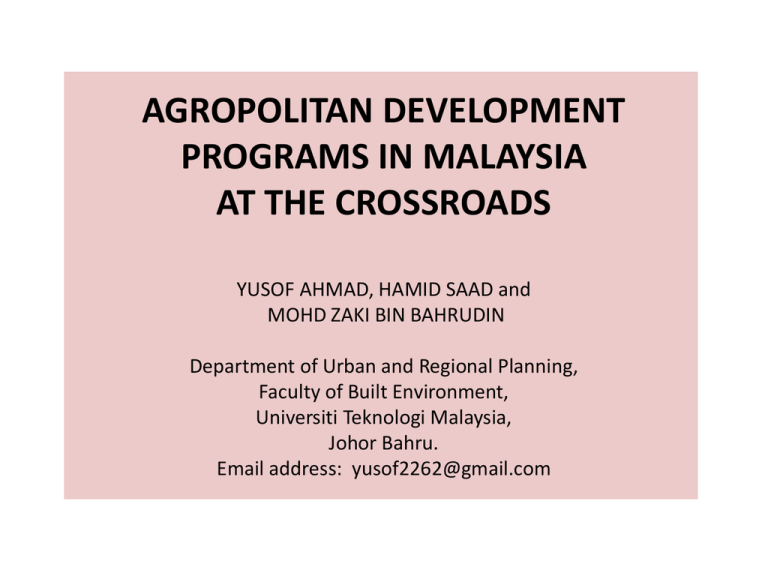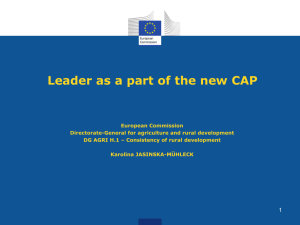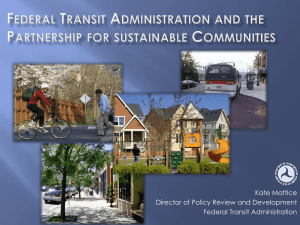RRPG5 – Yusof Ahmad
advertisement

AGROPOLITAN DEVELOPMENT PROGRAMS IN MALAYSIA AT THE CROSSROADS YUSOF AHMAD, HAMID SAAD and MOHD ZAKI BIN BAHRUDIN Department of Urban and Regional Planning, Faculty of Built Environment, Universiti Teknologi Malaysia, Johor Bahru. Email address: yusof2262@gmail.com 1. Introduction Since the era of independent, the government have engaged many policies to boost rural development in this country. This paper will discover the effectiveness of Agropolitan programme to solve the poverty issues in rural area. This research aims to examine the effectiveness and challenges of this programme in term of tackling the rural poverty issues. Finally, the future of this programme is discussed. 2. Agropolitan Development Programme • Agropolitan concept was developed as a new strategy of regional development practised in Malaysia and also in other developing countries. • This is because the concept of Growth Pole Theory (Teori Pertumbuhan Pusat) practiced since the 1970s cannot be fully accessed and adopted by developing countries. • As a result, the gap between urban and rural became more serious due economic flows to the central area are much larger than the flow to the rural economy • Finally, the idea of reducing the rural-urban difference was disrupted where urban areas were more benefiting as compared to rural areas. The worst effect was that more people were leaving the countryside for employment in urban areas. • John Friedmann & Mike Douglass 1975, developed a new approach which prefers basic needs approach and focus more on the development of rural areas through agricultural project concept. • The concept of the agricultural project is based on agricultural economy that grows and develops with the running of the system and the efforts of agribusiness that can serve and encourage agricultural business development activities (agribusiness) in the surrounding region (Yulistyo, 2008). • Agropolitan Development project was introduced in Malaysia in 2006 as a Quantum Leap Programme in eradicating rural poverty. i. AGRIPOLITAN DISTRICT Boundary of Agropolitant District Agricultural area 1 hour travelling time 10-25k population Agropolitant Centre with 10 – 25,000 inhabitants Total population : 50 000 159 000 majority involved in agriculture and farming ii. IMPLEMENTATION IN MALAYSIA In Malaysia, Agropolitan Programs are implemented by two implementing agencies, namely the Ministry of Rural and Regional Development (KKLW) and Public Private Cooperation Unit (UKAS) under the Prime Minister Department 3. Status Of Agropolitan Programme By UKAS No Location Status Project No. Participant 1 Kelantan Utara (1,000 ha) No 2,000 2 Kelantan Selatan (9,000 ha) Yes 3,000 3 Besut, Terengganu (2,045 ha) No 3,000 4 Pekan, Pahang (1,825 ha) Yes 5 Mersing, Johor (126.32 ha) No 1,450 Main Activity Seconder Activity ECER Sheep farming, cattle, fish planting cassava, oil, agriculture, ecoPenternakan tourism and homestay, rural industries, SMEs and business sheep Livestock and poultry processing herbal garden, rubber, timber, Oil palm agribusiness, akuaponik, eco-tourism and homestay, rural plantationCocoa industries, SMEs and business Catfish farming, goats, herbs, kenaf, agribusiness, ecotourism and Planting corn, homestay, rural industry, SME and business chilli Oil palm plantation Breeding sheep Secondary activities from sheep farming, akuaponik, mushrooms, herbs, bird's nest, agribusiness, ecotourism and homestay, rural industry, SME and business Eco-tourism, the development of integrated pineapple, cattle SDC Sabah Bil Location Status Project No. Participant Main Activity Seconder Activity Settlement and Facilities 1 Kota Belud, di Kuala Pintisan dan Rasok (921 ha) Source : ECERDC, 2013 No 550 Rubber cultivation Milk processing plants, and cattle breeding meat, organic fertilizer and and dairy cattle gas from cow dung Roads, water, electricity, telephone, construction of 550 houses, office buildings, car, tractor, children's playground, nursery schools, places of worship, halls serbaguna dan kemudahan asas lain 3. Status Of Agropolitan Programme By KKLW Bil Location Project Status No. of Participants Implementing Agency Main activity Commercial Activity Placement Peninsular Malaysia 1 Gahai, Lipis (238.7 ha) Yes 80 RISDA Rubber Bananas 50 housing units, Electricity and water, Hall, prayer, 5 shops 2 Chemomoi, Bentong (679.23 ha) No 200 RISDA Rubber Casava 200 housing units, Electricity and water, Hall, stalls, surau 3 Ganda, Gerik (1,230.3 ha) No 400 RISDA Rubber Undetermined 200 housing units, Electricity and water, Hall, stalls, surau 4 Sik (126.32 ha) No 50 KEDA Rubber Rice plants, fish cage 50 housing units, Electricity and water Sabah 1 Pulau Banggi (1,860 ha) Yes 200 FELCRA Rubber Fish Cage 200 housing units, Electricity and water, Kindergarten, prayer, stalls 2 Gana, Kota Marudu (1,696 ha) No 450 RISDA Rubber Nothing Nothing Sarawak 1 2 3 Gunung Dadok, Saratok (349 ha) RASCOM, Sibu (640.9 ha) Batang Sadong (605 ha) No 86 RISDA Rubber Nothing Nothing No 517 RISDA Rubber Nothing Nothing No 211 FELCRA Oil Palm Nothing Nothing 4 Batang Lupar, Sri Aman (1,595 ha) No 300 FELCRA Oil Palm Nothing 5 Pulau Bruit (495 ha) No 99 FELCRA Oil Palm Nothing Source : KKLW, 2013 126 housing units, Electricity and water, Booth, kindergarten, surau Nothing 4. Agropolitan Development Approaches By UKAS STATE GOVERNMENT ECERDC INVESTOR IMPLEMENTING AGENCY MANAGEMENT ACTIVITY FINANCES AGROPOLITAN PARTICIPANTS PHYSICAL COMPONENTS - Housing Lot -Basic Infrastructure -Utilities -Business Center FARMING / LIVESTOCK Employee Incentive Allowance and Working HUMAN DEVELOPMENT -Mental development Training -Skills Development -Entrepreneurship -Development FAMILY PARTICIPANTS ACTIVITIES AT THE FARM SUPPORTING ACTIVITIES Farm groups are managed by the agency Management / Co-participants and assisted by government agencies involved Akuaponik, mushrooms, beef integration, agribusiness, and tourism herbs Figure 2: Agropolitan Chart by UKAS • The implementation is supported by the main growth centers of economic activity, a secondary economy and support activities that will support growth opportunities and increase income for the population. This project involves the direct involvement of government agencies, private sector, universities and NGOs such as Agencies TEKUN Lembaga Tembakau Negara KADA KESEDAR FAMA JAKOA FELDA RISDA Jabatan Perkhidmatan Veterinar MARA Jabatan Perikanan Malaysia MARDI Lembaga Koko Malaysia LPP Lembaga Minyak Sawit Malaysia State Goverments 4. Agropolitan Development Approaches By KKLW STATE GOVERNMENT KKLW FEDERAL GOVERNMENT IMPLEMENTING AGENCY MANAGEMENT ACTIVITY FINANCES AGROPOLITAN PARTICIPANTS PHYSICAL COMPONENTS - Housing Lot -Basic Infrastructure -Utilities -Business Center FARMING / LIVESTOCK Employee Incentive Allowance and Working HUMAN DEVELOPMENT -Mental development Training -Skills Development -Entrepreneurship -Development FAMILY PARTICIPANTS ACTIVITIES AT THE FARM SUPPORTING ACTIVITIES Farm groups are managed by the agency Management / Co-participants and assisted by government agencies involved Akuaponik, mushrooms, beef integration, agribusiness, and tourism herbs Figure 3: Agropolitan Chart by KKLW • Physical Development includes the provision of settlement and infrastructure and social amenities such as homes, mosque, kindergarten / nursery, hall, playground, and business workshops, drains and drainage, roads in the settlement as well as water and electricity. • Human Capital Development the emphasis is dedicated to household heads (KIR) on aspects of the leadership of the community, family, spiritual, self-reliance and entrepreneurship. While members of the household (AIR) are also involved in academic improvement through tuition and exam preparation. • Economic Development involves two main components: Prosperous Farm (Ladang Sejahtera) development involves major community planting of rubber and oil palm. Commercial Activities (Ladang Komersil) farm are based on short-term crops, mainly aimed to support participants before gaining stable income from prosperous farm. Participants also have the opportunity to diversify its sources of income in manufacturing, packaging, marketing and business in premises or workshops available. This project involves the direct involvement of others agencies such as: • • • • • • • • • Lembaga Penyatuan dan Pemulihan Tanah Persekutuan (FELCRA Berhad) Majlis Amanah Rakyat (MARA) Pihak Berkuasa Kemajuan Pekebun Kecil Perusahaan Getah (RISDA) Jabatan Kemajuan Masyarakat (KEMAS) Jabatan Kemajuan Orang Asli (JAKOA) Institut Kemajuan Desa (INFRA) Lembaga Kemajuan Terengganu Tengah (KETENGAH) Lembaga Kemajuan Wilayah Kedah (KEDA) Lembaga Kemajuan Johor Tenggara (KEJORA) 6. Study Area and Analysis Table 1: List of Study Area Implementer Agencies UKAS KKLW Study Area Total Area Agropolitan Pekan, Pahang 1,825 hectares Agropolitan Gua Musang, Kelantan 9,000 hectares Agropolitan Gahai, Pahang 238.7 hectares Agropolitan Pulau Banggi, Sabah 1,860 hectares i. Study Area Figure 1: Location of Study Area Images of Study Area KKLW Pulau Banggi Tanjung Gahai Images of Study Area UKAS Gua Musang ii. Research Methodology • A field survey using questionnaires was carried out in April to June 2013 both at all 4 locations. • 100% (661 nos) survey were conducted on agropolitan participants (head of household) to explore their experiences before and after joining the projects. • The participants were all 20 years of age or older. • The achievement of economic, physical and human development transformation were the target to be examined. iii. SAMPLING Study Area Location Household Percentage (%) Tanjung Gahai, Pahang 50 100 Pulau Banggi, Sabah 96 100 Pekan, Pahang 200 100 Gua Musang, Kelantan 315 100 TOTAL 661 100 iv. Analysis and Discussion • The Agropolitan project implemented by the ECER and KKLW, contributed to remarkable progress of the rural transformation. The participants’ statements, were classified into several categories namely socio-economic aspects, physical and human development. • From 661 questionnaire distributed, 78 participant gave no answer (11.8%) Table 1.1 : Finding from UKAS Agropolitan Programme Transformation form Statement Pekan Percent (%) Economic improvement Increased job opportunities 87 3 43.5 1.5 Gua Musang 124 5 stability of income 4 2 4 1.3 Gainful activity 4 2 4 1.3 Higher income, and economic activity profitable Poverty reduction and improved quality of life 30 15 32 10.2 Poverty reduction, reduction in the number of poor people Total in this segment 128 64 169 53.7 Settlements and housing repairs 7 3.5 11 3.5 the agricultural sector 11 5.5 25 7.9 Total in this segment 18 9 36 11.4 Effects of atmosphere of comfort 4 2 42 13.3 A better life, feel more secure life easier, more organized, more coordinated economic activity, future opportunities better and more secure life. increased life 17 8.5 25 7.9 Style of modern life, people happy, life is more comfortable and happy 6 3 8 2.5 Increased collaboration, activities, and positive competition and increase the life Total in this segment 27 13.5 75 23.8 Total 173 86.5 280 89.2 Economic transformation Physical transformation Human resources transformation Solidarity, increase the life, the existence of healthy competition Percent (%) 39.4 1.6 Statement Continued economic resources, increase work participation activities and increasing opportunities Construction of new homes, there is a stone house, a bigger house and a beautiful and growing population that settled there. Free land for cultivation, supply of pesticides, fertilizers, agricultural materials, free of seeds and planting more stable. A total of 62 (12.1 percent) did not answer the questions posed Table 1.2 : Finding from KKLW Agropolitan Programme Transformation form Statement Pulau Banggi Percent (%) The increase in revenue Improved economic 17 7 17.7 7.3 9 3 18 6 poverty reduction 2 2.1 1 2 Economic Employment transformation opportunities on the basis of agriculture Physical transformation Tanjung Gahai Percent (%) 2 2.1 2 4 Total in this segment 28 29.2 15 30 Improvement of facilities and agricultural work 5 5.2 3 6 Availability of basic amenities and facilities 13 13.5 13 26 Total in this segment 18 18.7 16 32 Improved quality of life 22 22.9 5 10 increased comfort 19 19.8 7 14 Total in this segment 41 42.7 12 24 Total 87 90.6 43 86 Human resource transformation Statement Help supplement the family income, no job opportunities, increase their income by working in the farm Availability of employment opportunities in the plantation sector, producing many projects Availability of basic amenities like water and electricity and no roads, the situation has improved Improved living standards, there are many employment opportunities and socio-economic change participants Changes difficult become easier, more change lifestyle, change our old life into a new direction with a new facility A total of 16 persons (10.9 percent) did not answer and assumed no change 7. Research Findings • Economic transformation : This is most acknowledged responses by the participant (UKAS : 59% and KKLW : 30%) • Related to economic change aspects are existence of income enhancement, more working opportunities and profitable activities, income stability, and poverty reduction. i. Economic progress Before < 300 Income % After 29% < 300 Notes % 0 RM 301-600 64% RM 301-600 6% RM601-900 RM901-1200 RM1201-1500 5% 2% 0 RM601-900 RM901-1200 RM12011500 30% 62% 3% Total 100 There is no participant with income less than RM 300.00 monthly found This income bracket declined to about 58% Income increased by 25% Income increased by 60% Income increased by 3 % 100 Table above shows the participants economic improvement in a monthly basis income comparison before and after joining the agricultural project. • Significant income progress occurred in two income brackets; from RM 601-900 (increased by 25 percent), from RM 901 to 1200 (increased by 60 percent). • Whereas at income bracket of RM1201 to RM 1500 only increased by 3%. • Substantial changes also seen in the income category of RM 301-RM 600 which shows the disappearance of people with very low income. • The economic capability of participant in regard of income was boosted and as a larger impact, the hardcore poverty were eradicated. ii. Transformation in Physical Environment Free land for cultivation, supply of pesticides, fertilizers, agricultural materials, free of seeds and planting more stable. Construction of new homes, there is a brick house, a bigger house and a beautiful and growing population that settled there. Availability of basic amenities like water and electricity and no roads, the situation has improved (UKAS : 10 % and KKLW : 25 %) iii. Transformation in Human Development • Involvement of government agencies in collaboration with universities such as UMK and UMT in Kelantan and Terengganu. • Increased cooperation and interaction among themselves, healthy competition, increased activities and improve their spirit. • Life become more comfortable, having better quality and more secured life, and look forward to better future • (UKAS : 19 % and KKLW : 34%) 8. The Challenges Of Agropolitan Implementation The challenges can be categorized according to pre, during and after project implementation as below:1. Unavailability of new land for this projects 2. Involves allocation of huge amount of cost to start and run the project 3. Unavailability of manpower from the implementing agency side 4. Unsuitability of soil condition 5. High infrastructure and development cost due to remoteness of location 6. Suitability of the identified projects are not in accordance with site conditions 7. Constraints in identifying the right participants. Hardcore poverty people are normally at the end of working age. 8. Lack of skill, knowledge and ageing of participants 9. Dependency on foreign worker instead of participants 10. Difficulty in determining the right number of target participants 11. Weak project management because it involves long bureaucracy between inter and intra government agencies 12. Difficulty in adapting the original concept due to physical factors 13. Existing projects still rely on government intervention and agencies 14. Participants are too dependent on government and implementing agency input. Top–down instead of bottom-up 15. Question of self-sustain of the project. How long can the implementing agencies hold on with the project. 16. Who are best to manage the project after it has been implemented 17. Are we willing to spend so much for very few people? 18. Project stuck halfway 9. The Proposals To Improving Agropolitan Programme This includes the identification of the : • • • • Project location, Planning of project area, Project implementation, and Project management. A new mechanism has been proposed as an effort to improve the program so that its effectiveness can be enhanced. AVOID SPENDING BEFORE FULL PROJECT APPRAISAL AND SOSIO ECONOMIC ANALYSIS ARE APPROVED • Identification of Project location Vacant government land is scarce nowadays. In situ development is the most probable as compared to new development. Traditional villages with vast unutilized land privately owned should be the main focus • The authorities and the main implementing agency should conduct feasibility study to identify the areas that are most suitable site for development, which previously only focused on the identification of areas of government or Malay reserve area only. Now identification must also consider the strategy of the location in order to gain profit as has been projected. • Target participant Target participant should not only cover hardcore poverty. Rather it should include everybody who are in the poverty classification. More importantly, those chosen must be healthy, younger and have the will power to work in the project • Planning of the Project Area The project area that has been identified should be provided with the adequate facilities. In fact, the number of participants should be targeted compatible with the size of the area and are relevant to the site. • Project Implementation The agency responsible should ensure that projects are controlled to achieve the desired target. Governs transparency will be paramount. Infrastructure must be built to achieve high standards set by any agency. This is because in the case of Pulau Banggi, Sabah, all the facilities built did not meet the standards set by the local technical agencies. • Project Management As an effort to streamline the Agropolitan program, Malaysia needs to develop its own mechanism in shaping the agricultural project model that fits the situation in the country. The original concept which was introduced did not fully materialized due to some problems arise in the site. New Concept To Improving Agropolitan Programme -MERGING OF AGROPOLITANT AND RTCTOWARDS A MORE CONCERNTRATED APPROACH Three of these components serve as the main criteria that must be adapted to this concept as follows: • RTC center • Integration of Land Agropolitan • Growth Centre Known as ‘Mini Agro’ FOCUS ON UN-UTILISED LAND (TANAH TERBIAR) FUNDING FROM PRIVATE AND PUBLIC SECTOR RTC Centre Settlement Integrated Land Agropolitan Access farm to RTC Main access/ Linkages IMPLEMENTATION OF AGROPOLITANT PROJECT IN OVERSEAS SUCH AS INDONESIA DOES DOT DEPEND SO MUCH ON PUBLIC FUND 10. Conclusion • The agricultural project implementation used two different methods but have the same goal which is to develop rural areas. • Less strategic location has also prevented the implementation of this program, particularly involving areas in Sabah and Sarawak. Here the selected should not be simply based on availability, but must be feasible and strategic as well. • A combination of a few mini agropolitan will then help to form agropolitan and RTC. • Finally, it is time for the relevant authorities to rethink whether is necessary to continue the program with previous methods, as this program has incurred so much capital expenses. • A more effective approach is hereby highlighted. THANK YOU THANK YOU TERIMA KASIH Contents 1. Introduction 2. Agropolitan Development Programme 3. Status Of Agropolitan Programme By UKAS and KKLW 4. Agropolitan Development Approaches By UKAS 5. Agropolitan Development Approaches By KKLW 6. Study Area 7. The Challenges Of Agropolitan Implementation 8. The Findings of Study 9. The Proposals To Improving Agropolitan Programme 10. Conclusion 3. Government Transformation Programme In 2012, the present Prime Minister Dato’ Seri Mohd Najib Tun Razak launched another development programme which is known as ‘Government Transformation Programme’ which include the rural sector also. The initiatives include: • Enhancing water supply distribution and treatment system : Upgrades will be made to the existing system to ensure that the expansion of water delivery will not overly tax the existing supply. • Rural electrification programme : Schools in rural areas will be connected to the main grid to reduce their dependence on diesel generators thereby lessening their fuel cost and ensuring that there is a more stable supply of electricity. Hybrid systems will also be used to deliver electricity to rural households. • Maintenance of infrastructure : This initiative aims to monitor and maintain roads and power generators in rural areas.”






